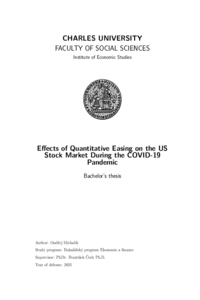Effect of Quantitative Easing on the US Stock Market During the COVID-19 Pandemic
Vliv kvantitativního uvolnění na americký akciový trh během pandemie COVID-19
bakalářská práce (OBHÁJENO)

Zobrazit/
Trvalý odkaz
http://hdl.handle.net/20.500.11956/126543Identifikátory
SIS: 225858
Kolekce
- Kvalifikační práce [19618]
Autor
Vedoucí práce
Oponent práce
Džmuráňová, Hana
Fakulta / součást
Fakulta sociálních věd
Obor
Ekonomie a finance
Katedra / ústav / klinika
Institut ekonomických studií
Datum obhajoby
9. 6. 2021
Nakladatel
Univerzita Karlova, Fakulta sociálních vědJazyk
Angličtina
Známka
Výborně
Tato práce zkoumá účinky kvantitativního uvolňování na různé akciové in- dexy ve formě S&P 500, NASDAQ-100, DJIA a Russell 2000. Účinky jsou analyzovány implementací standardních statistických metod a modelů ARMA- GJR-GARCH. Týdenní údaje o celkových aktivech držených Fedem a data oznámení kvantitativního uvolňování jsou použity jako proměnné představující kvantitativní uvolňování. Byl nalezen silný pozitivní vztah mezi kvantitativním uvolňovánňm a indexy akciových trhů, s nejvýznamnějším účinkem na Rus- sell 2000. Zahrnutí kvantitativního uvolňování do ARMA rovnice vizuálně vy- padalo, že vysvětluje určitou volatilitu trhu po oznámení Fedu o kvantitativním uvolňování, ale statistické metody tuto hypotézu nepotvrdily.
This work examines the effects of quantitative easing on different stock in- dices in the form of S&P 500, NASDAQ-100, DJIA and Russell 2000. The effects are analysed through the implementation of standard statistical methods and ARMA-GJR-GARCH models. Weekly data on total assets held by Fed and announcement dates are employed as variables representing quantitative easing. A strong positive relationship between quantitative easing and the stock market indices was found, with the most significant effect on the Russell 2000. The in- clusion of quantitative easing in our ARMA equation visually seemed to explain some of the market's volatility after the Fed's announcements of quantitative easing, but statistical methods did not confirm this hypothesis.
